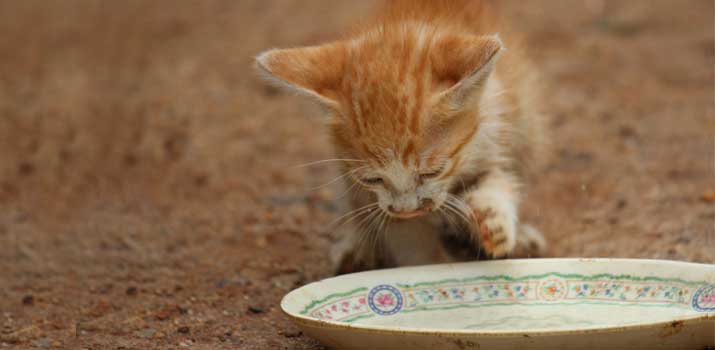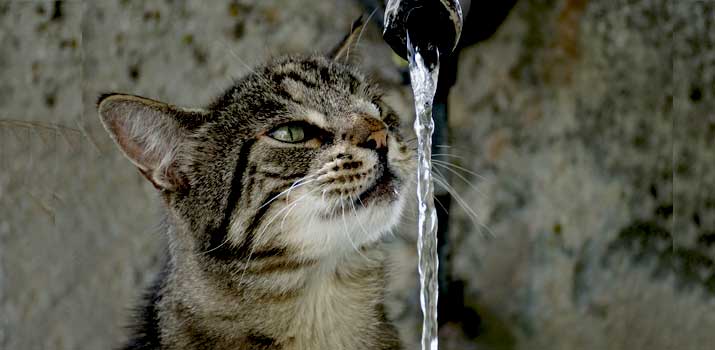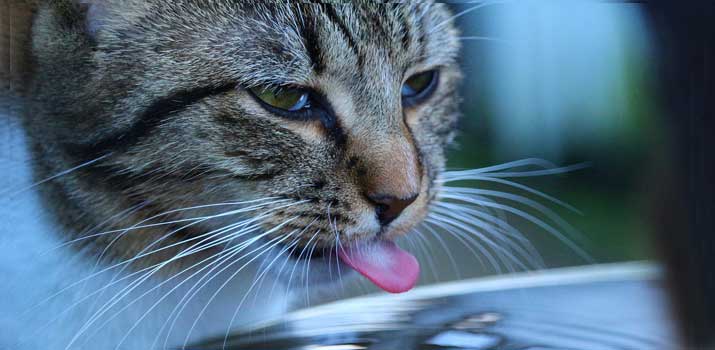
It doesn’t matter whether your cat is still a youngster or you’ve had them for years. You probably have their eating and drinking cycles down pat.
You know what to expect, how much they consume, and how they behave when doing it. That’s a good thing! Understanding what’s normal for your cat can help you spot potential issues when they arise.
One phenomenon that’s sure to catch you off guard is excessive drinking and loud vocalizations.
The constant meowing is enough to raise a red flag if your cat usually is quiet. But when you add the change in drinking patterns to the mix, there is cause for concern.
Polydipsia
Extreme thirst, also known as polydipsia, is not normal.
A cat’s hydration needs can change based on daily activities and what it eats. But there’s a noticeable difference with polydipsia.
The newfound thirst comes suddenly and may even be one of many erratic behaviors. So, what does it mean when your cat suddenly drinks a lot of water and meows more than usual?
How Much is Too Much?
Before worrying, let’s talk about how much water is considered “too much.”
Typically, getting your cat to drink more water is a good thing. So many owners struggle to encourage cats to stay hydrated. But when does it cross the line into excessive?
That all depends on what’s normal for your cat. Some cats will drink tons of water every day. Meanwhile, others get by on small sips here and there.
As a good rule of thumb, experts recommend about 100ml of water per kilogram of body weight for cats. 100ml is about the equivalent of about 0.42 cups.
So, let’s say you have a cat that weighs about 4.5 kilograms (roughly 10 pounds). A 4.5kg cat must drink approximately 450ml of water daily to stay healthy. That’s just under two full imperial cups.
Fluctuations
Of course, there are fluctuations in how much your cat drinks.
If they are relatively active, they might consume more. Meanwhile, lazier cats might need to drink less. But the 100ml/kg of body weight rule is a good reference point.
Consider measuring how much your cat usually consumes. See how much your cat’s water bowl holds, and keep an eye on consumption throughout the day.
You may need to take action if it’s more than the recommended amount. Any sudden changes should be a cause for concern, too. Anything out of the ordinary often signifies an internal change and a potential health problem.
What’s with the Meowing?
The meowing is one of the more concerning bits of this odd behavior. If your cat is typically not super vocal, it can catch you off guard.
Cats meow for many reasons. As a whole, it’s a way to capture your attention. Think of it as a form of communication. Your cat is trying to tell you something!
If the meowing occurs whenever your cat goes in for a drink, that could be their way of telling you that something’s seriously wrong. Cats don’t know why or how they’re feeling unwell, but they will cry out for help if necessary.
It’s their way of saying they want you to help, so it’s not something you should ignore.
Possible Innocent Reasons for this Behavior
Not every instance of this behavior is dire. Before we get into the more serious stuff, here are a few relatively innocent reasons why your cat might be meowing and drinking more water than usual.
Dehydration Recovery
Was your cat recently sick? Maybe they experienced a brief illness or started to throw up but acted normal afterward.
Whatever the case, this action might be nothing more than a form of recovery.
Cats know when they’re dehydrated. They might not feel like drinking water when sick, but they’ll start up again once they feel better.
The increased thirst is a byproduct of dehydration, and cats will try to make the difference once they’re up to it. They compensate for the fluid loss by drinking as much as they can.
As for the meowing, it could be their way of telling you to keep things filled!
For example, your cat might drink so much that the water starts running low. In that case, the meowing is their way of saying it’s time to top up!
You might even see them pawing at the bowl.
Exploring a New Drinking Vessel
Earlier, we talked about how some owners struggle to get their cats to drink more water. You see, cats instinctively don’t like to sip from still water.
In the wild, standing water usually contains tons of bacteria and other microorganisms that might make them sick.
Having a regular old water bowl isn’t ideal, and many cats will avoid drinking from it until they’re on the brink of dehydration.

One way to get around this issue is to provide a water vessel that keeps the liquid moving.
We’re talking about water fountains and other dishes with an integrated pump. The sound of moving water and light splashes is enough to get any cat drinking.
Don’t be surprised if you see your cat go wild exploring this new drinking accessory!
Hotter Temperatures
Of course, cats will drink more when it’s hot out. They’re like humans and dogs in that sense. During the summer, scorching temperatures make it hard for cats to stay cool.
They have their instinctive behaviors to lower their body temperature. One example is more frequent grooming.
But one of the best ways to cool down is to drink more water. You’ll see your cat returning to the fountain or bowl more often, so keep it filled. Your feline friend might meow more, too.
In this context, it’s more of a complaining meow to let you know they’re sick of the heat
Related: !How Cold is Too Cold for Cats in House
A Dietary Change
Finally, dietary changes could be to blame for the sudden shift in drinking patterns.
What food your cat eats can dictate a lot of what they do. It’s intrinsically linked to their health and behavior.
Switching to a new formula could trigger more drinking. However, the most likely scenario is switching from wet to dry food.
Many owners start with wet food only to realize that their feline friends can benefit from a bit of crunch. Dry food tends to be better for dental purposes. So, they switch to a dry food product.
Suddenly, your cat is getting significantly less hydration from their food. As a result, they turn to the water bowl!
Related: Why Your Cat Refuses to Eat Wet Food
Potential Medical Concerns
Unfortunately, there’s a good chance that your cat is meowing and drinking lots of water for medical issues.
If you notice that your cat’s water consumption has increased significantly, don’t hesitate to take them to a vet.
This is a pressing matter, and getting your cat veterinary care as soon as possible can make all the difference.
There are a few different health concerns that cause increased drinking. Here are some of the most common.
Urinary Tract Infections
The best-case scenario is that your cat has a urinary tract infection (UTI).
This condition is relatively common, and most cats experience it at some point in their life. While it is painful, it doesn’t compare to some of the other possible issues.
A UTI occurs when bacteria or debris gets into the urethra. It can cause intense pain and burning whenever your cat uses the litterbox.
You might also notice blood in the urine, obsessive grooming of sensitive areas, and a general hesitation to urinate.
Drinking water is your cat’s attempt to make the issue pass. It’s a good technique because UTIs and dehydration are sometimes linked. Staying hydrated is a plus.
Veterinary care is a must for UTIs. Sometimes, infections are a byproduct of a more severe illness. If left untreated, the infection can spread and cause other complications. Luckily, UTIs are relatively easy to treat with antibiotics.
A Symptom of Diabetes
Diabetes can affect cats, dogs, and many other animals. It’s not a human-exclusive condition.
When a cat has diabetes mellitus, it means one of two things.
It either means that your cat’s pancreas isn’t producing enough insulin, or its body isn’t responding to the insulin as it should. That’s the difference between the various diabetes types.
No matter what kind of diabetes your cat has, its body isn’t reacting well to it. Imbalanced insulin levels can lead to extreme blood sugar changes.
Insulin is critical in glucose control, so many cats with diabetes will have naturally high blood sugar. Drinking a lot of water is your cat’s feeble attempt to dilute the blood and restore balance.
Of course, that doesn’t work. The only way to treat feline diabetes is through insulin therapy. Failing to address this condition can lead to many complications and eventual death.
Hyperthyroidism
Hyperthyroid is a condition that frequently affects senior cats. It’s similar to diabetes, but instead of insulin issues, it revolves around hormones produced by the thyroid.
The thyroid gland controls hormonal production for things like metabolism.
With hyperthyroidism, the gland creates more hormones than necessary. As a result, cats will experience a significant boost in metabolism.
Their energy levels will skyrocket as they burn through calories. Extreme thirst is one of the many possible symptoms.
Veterinarians treat hyperthyroidism in a few different ways. They might recommend prescription medication, iodine therapy, or even surgical removal. Either way, heed your vet’s advice.
Hyperthyroidism can lead to significant lifestyle changes and eventual death.
Related: What to Feed a Hyperthyroid Cat?

Liver Disease
In some cases, increased third levels and meowing can signify that your cat is experiencing painful liver issues.
The liver is a crucial organ that performs many biological functions. It filters waste, metabolizes fats, and more.
When something goes wrong with the liver, it’s not one function that suffers. Your cat’s overall health can fall, and many complications can occur.
A few common forms of liver disease include bacterial infections, tumors, and Hepatic Lipidosis.
Infections occur when bacteria travel from the intestines to the liver. The bacteria Neutrophilic Cholangitis is usually to blame. Once inside the liver, it causes inflammation that negatively impacts the organ’s performance.
Tumors, both benign and malignant, can form in the liver and change how the organ does its job. Unless surgically removed, dysfunction will continue.
Hepatic Lipidosis, also known as fatty liver disease, happens when fat accumulates in the organ. It requires immediate attention and careful management moving forward.
For all of these forms of liver disease, cats drinking more water is a common symptom. Your feline friend might also lose their appetite, experience stomach problems, vomit regularly, and more.
Liver disease is a severe and potentially life-threatening issue that needs to be addressed as soon as possible.
Kidney Failure
The kidneys are also vital organs responsible for filtering waste. They handle toxins that could harm your cat, allowing them to pass unscathed.
Kidney disease happens when these crucial filtering organs are incapable of performing as they should. The condition prevents the kidneys from producing concentrated urine.
As a result, cats will urinate more often and lose hydration. Drinking more water is their solution to replenish what they lose.
Unfortunately, kidney disease can kill cats, and many cases go undiagnosed.
Bring your cat to a vet immediately if you suspect they have kidney disease. After a proper diagnosis, you can work with your vet to manage the condition and prolong your cat’s life as long as possible.
Getting Help
We don’t mean to scare you, but behavior like this isn’t normal.
While there are undoubtedly innocent reasons why your cat might be drinking a lot of water and meowing, there’s a good chance that health issues are to blame.
Don’t wait to get help. Addressing whatever is affecting your cat is the main priority. The earlier you get veterinary care, the better the prognosis.
Take those meows as a cry for help, and do what you can to provide relief.
Also read: How Much Attention Do Cats Need

